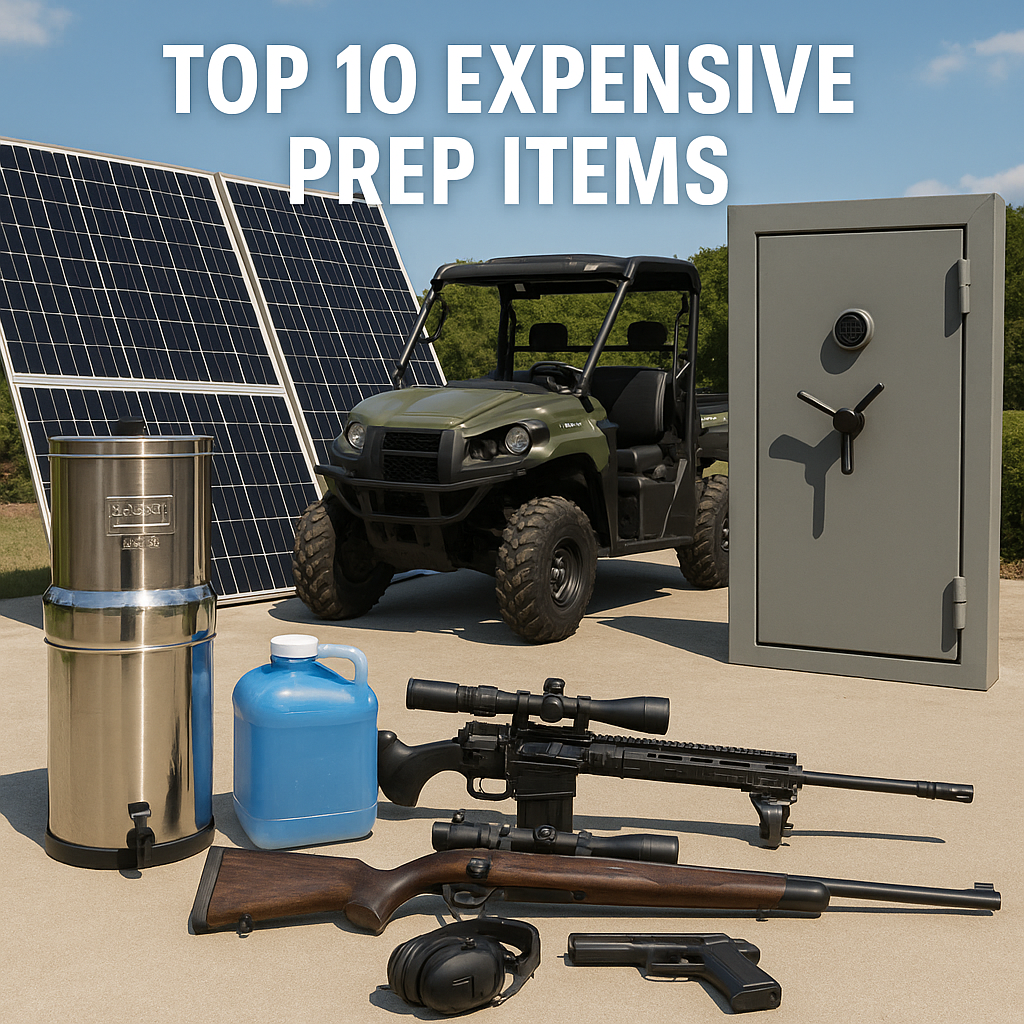When most people think of prepping, they imagine storing food, stocking batteries, and buying a few basic survival tools. But as any experienced prepper knows, true long-term preparedness goes beyond the basics. Some of the most valuable preps are also the most expensive — not because of luxury, but because they represent long-term sustainability, independence, and security when the world goes dark.
Below are the top 10 expensive prep items that may cost a fortune upfront but could save your life — and your sanity — when everything else fails.
1. Solar Power Systems
A complete solar setup—panels, charge controllers, battery banks, and inverters—can easily cost $10,000 to $30,000, depending on your power needs and setup complexity.
Why It’s Worth It:
When the grid goes down, having a steady, renewable power source separates the comfortable from the desperate. Solar systems power essential systems: freezers, lights, communication gear, water pumps, and medical equipment. Unlike generators, they don’t require fuel, make no noise, and have minimal maintenance needs once installed.
Pro Tip: Combine your solar array with a high-quality lithium battery bank and a backup propane or diesel generator for cloudy periods.
2. High-Capacity Water Filtration Systems
Clean water is survival’s most basic requirement, and large-scale filtration systems—like Berkey, Katadyn, or reverse osmosis units—can cost $2,000 to $5,000 when sized for an entire homestead.
Why It’s Worth It:
A reliable water system can handle hundreds of gallons daily, filtering out bacteria, parasites, and heavy metals. This ensures not just survival but health and sanitation. Add solar-powered UV purification or rainwater harvesting for redundancy.
Pro Tip: Invest in spare filters and pre-filtration setups for muddy or silty sources.
3. All-Terrain Vehicles (ATVs/UTVs)
Mobility is key during emergencies. Off-road vehicles like Polaris Rangers, Honda Pioneers, or used military quads can run $8,000 to $25,000.
Why It’s Worth It:
When roads are blocked or fuel is scarce, ATVs can haul supplies, move livestock feed, or transport the injured. A UTV with a cargo bed doubles as a mobile work truck and can operate on minimal fuel or even converted biodiesel.
Pro Tip: Store spare parts and learn basic maintenance—your vehicle might be your escape plan.
4. Long-Term Food Storage
Freeze-dried meals, canned goods, and bulk dry staples for one year of family survival can easily total $5,000 to $15,000.
Why It’s Worth It:
Food inflation, supply disruptions, and contamination events make having your own food stockpile critical. Premium freeze-dried food lasts up to 25 years, offering complete nutrition and peace of mind.
Pro Tip: Rotate your food yearly and supplement with garden produce, dehydrated fruit, and home-canned meat.
5. Night Vision and Thermal Optics
Owning the night is a major tactical advantage. Gen 3 night vision goggles and thermal scopes cost $2,000 to $10,000.
Why It’s Worth It:
Visibility after dark can prevent ambushes, help locate lost livestock, or detect intruders at your perimeter. Thermal imaging works through fog and darkness, giving you an early warning system.
Pro Tip: Combine thermal optics with motion sensors and low-power infrared cameras for 24-hour coverage.
6. Secure Bunker or Safe Room
A hardened underground shelter or reinforced panic room may cost anywhere from $20,000 to $100,000+, depending on construction.
Why It’s Worth It:
Protection from tornadoes, radiation, or civil unrest is priceless. A properly designed bunker provides long-term safety, storage for gear, and a controlled environment.
Pro Tip: Don’t overlook ventilation and air filtration—carbon filters and blast valves are as important as thick walls.
7. Advanced Medical Equipment
Medical gear goes beyond first-aid kits. Fully stocked trauma kits, oxygen concentrators, portable ultrasound devices, and AEDs can total $2,000 to $10,000.
Why It’s Worth It:
When hospitals are inaccessible, advanced medical tools make your group self-sufficient. Combine them with proper training in trauma care, wound management, and field surgery.
Pro Tip: Invest in courses—gear is only as good as the person using it.
8. Quality Firearms and Optics
Dependable firearms for hunting and defense are expensive, especially when you factor in optics, accessories, and ammunition. A solid collection can range from $5,000 to $20,000.
Why It’s Worth It:
In a world without law enforcement, self-defense and food acquisition fall squarely on you. Reliable firearms mean reliability in the worst moments.
Pro Tip: Train regularly and stock reloading supplies to extend your ammo reserves indefinitely.
9. Land for a Bug-Out Location
Rural acreage with water access, fertile soil, and a defensible position is the ultimate prep investment—often between $100,000 and $500,000+ in Canada.
Why It’s Worth It:
Land gives you independence: you can produce food, harvest timber, and secure your perimeter. It’s not just survival land—it’s a legacy that can support multiple families for generations.
Pro Tip: Prioritize land with natural water features, forested sections, and southern exposure for solar power.
10. Communication and Surveillance Systems
A reliable off-grid communication network—ham radios, repeaters, antennas, cameras, and power backups—can total $2,000 to $8,000.
Why It’s Worth It:
Information is survival. When the grid is down, being able to reach nearby allies, monitor broadcasts, or track intrusions gives your group an edge.
Pro Tip: Learn to use ham radio properly, and store spare Baofengs and antennas in a Faraday bag.
Bonus: The Value of Training
The best gear in the world is useless without skill. If you have limited funds, prioritize knowledge first—medical training, mechanical skills, and wilderness survival courses will always yield higher returns than any piece of gear.
Final Thoughts
Expensive prep items may not fit every budget, but they’re part of a bigger picture—sustainability, security, and self-reliance. You can start small, but every serious prepper should plan for these major upgrades over time.
When the world gets chaotic, these investments transform from “luxury items” into the foundations of a new, independent way of living. In survival, quality isn’t a luxury—it’s a necessity.




